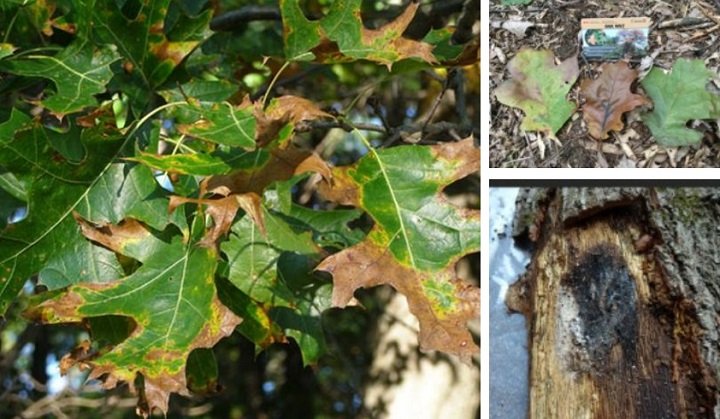Oak wilt found in Canada for first time, sparking concern disease could spread and kill trees
Posted June 27, 2023 6:45 pm.
Last Updated June 27, 2023 7:27 pm.
For the first time, federal government officials say a fungal disease called oak wilt has been confirmed to be in Canada — a discovery that is sparking concern about how it could impact oak trees.
“At this point, there’s no cure for oak wilt. Once a tree becomes infected, it will die. If it’s a red oak, it’ll die within one growing season. Oak wilt can survive with the pathogen for a little longer,” Nicole Mielewczyk, a plant health survey biologist with the Canadian Food Inspection Agency (CFIA), recently told CityNews when asked about the severity of the disease.
Mielewczyk said the agency received a pest report from an arborist on May 23 after they were called to remove three dead trees in northern Niagara Falls. A week later, a laboratory confirmed it was oak wilt.
She said the CFIA has been anticipating the arrival of the disease for years, forcing staff to come up with a response plan once it showed up. The prospect of the disease spreading to oak trees is daunting.
“Red oaks are very popular throughout Ontario, which is why the Canadian Food Inspection Agency is working with partners to help reduce the risk of the spread of this pest,” Mielewczyk said.
RELATED: Spread of invasive species in Canada costs billions, changes environment
In Toronto, oak trees are present throughout the city. Oaks were named the official tree of Toronto during a ceremony in 2022.
As for how the fungus got here, it’s not entirely clear.
“We don’t typically speculate on the specific pathway that led to the introduction in a new area,” Mielewczyk said when asked about transmission.
“We consider all possible pathways and use that to help inform the next steps, so we don’t have a leading theory at this point. We’re more focused on follow-up actions.”
Generally speaking, Mielewczyk said the closest confirmed detection of oak wilt is roughly 150 kilometres away (in upstate New York) from the site in Canada.
She said it’s possible the fungus was in with oak or other natural materials that were moved a long distance, reiterating long-standing advice against transporting firewood between regions.
Once it’s present, beetles landing on trees with oak wilt spores can fly up to 1.5 kilometres away and spread the spores to other trees. If a tree has oak wilt, it can also go through the tree and spread to another tree by interconnected roots. Trees damaged by lawn maintenance equipment or through other means make it easier for spores to get into the tree. It was recommended tree pruning shouldn’t be done between April and August at a minimum (ideally closer to November) to help minimize risks

Leaves and trees damaged by oak wilt can be seen in these undated photos. INVASIVE SPECIES CENTRE / Handout
Madison Sturba, a program development coordinator with the Ontario-based Invasive Species Centre, urged residents with oak trees to be cautious.
“I think the main thing right now is just to really learn about the signs and symptoms of oak wilt and to just monitor the health of your oak trees,” she told CityNews.
“It could be a big problem … It can impact individual trees quite quickly. It’s a slow-moving disease overall, but it is something definitely that we should still be monitoring.”
Sturba and Mielewczyk said the most noticeable sign of the disease is a smell coming from the tree, which was described as being similar to Juicy Fruit or fermented fruit wine. Other indicators include vertical bark cracks, bronzing and wilting leaves starting at the top and premature leaf dropping.
CityNews contacted the City of Niagara Falls to ask how municipal staff would be responding to the detection in the community, but a representative referred questions to the CFIA. Mielewczyk said staff from a variety of entities will be conducting surveys in the area to see if oak wilt has been detected elsewhere.
Meanwhile, officials with the CFIA, Invasive Species Centre, and the City of Niagara Falls will be hosting an online information session on Thursday at 11 a.m. Click here to register for the session.








